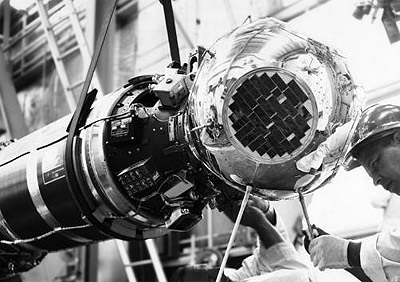Thank you very much for visiting Gunter's Space Page. I hope that this site is useful and informative for you.
If you appreciate the information provided on this site, please consider supporting my work by making a simple and secure donation via PayPal. Please help to run the website and keep everything free of charge. Thank you very much.
SEV

SEV (left) with SECOR 5 (right) [NASA]
SEV (Scout Evaluation Vehicle) was a NASA launch vehicle evaluation payload to test a new version of the Scout launch vehicle and performing new maneuvers during launch. Primary purpose of the experiment was to demonstrate in flight the operation of a number of improved vehicle features which had been developed for the Scout program.
These included:
- The Scout's capability to fly a "dog-leg" course from Wallops Island by a guidance technique known as yaw torquing.
- The use of new second and fourth-stage rocket motors with improved thrust characteristics.
- Test in-flight performance of improved spin motors to stabilize the fourth stage of the vehicle.
- Demonstrate the Scout air transportability concept by launching a vehicle which after complete assembly at Wallops, has been airlifted from and returned to the launch site in simulation of a transcontinental trip.
Because engineering evaluation of the Scout system performance was the primary purpose of the flight, special instrumentation and telemetry packages had been provided for gathering a number of measurements in addition to those regularly made. A precision velocity meter made very accurate measurements of vehicle velocities through fourth-stage burning. Other instruments measured vibration, temperatures, motor pressures, spin-motor performance, ignition system voltages and other quantities needed for a complete engineering evaluation of the performance of the improved Scout. Electrostatic charge measurements were made on stages two and three. Improved solid-state telemetry systems were used to reduce weight and increase reliability. Finally, a new lightweight radar tracking beacon was carried on the vehicle.
Although it carried a heavy load of special engineering instrumentation, the SEV Scout made use of a small excess payload capability by carrying a 20.4 kg SECOR 5 satellite payload furnished by the U.S. Army. However, achievement of an orbit for the bonus experiment, SECOR, was not a primary objective of this mission.
| Nation: | USA |
|---|---|
| Type / Application: | Vehicle evaluation |
| Operator: | NASA |
| Contractors: | |
| Equipment: | |
| Configuration: | |
| Propulsion: | None |
| Power: | Batteries |
| Lifetime: | |
| Mass: | |
| Orbit: | 1134 km × 2425 km, 69.24° |
| Satellite | COSPAR | Date | LS | Launch Vehicle | Remarks | |
|---|---|---|---|---|---|---|
| SEV | 1965-063B | 10.08.1965 | WI LA-3 | Scout-B | with SECOR 5 |
References:
- NASA press kit: Project: Scout Evaluation
